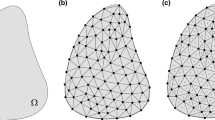Abstract
Bone remodeling occurs in an adult’s skeleton to adapt its architecture to external loadings. This involves bone resorption by osteoclasts cells followed by formation of new bone by osteoblasts cells. During bone remodeling, osteoclasts and osteoblasts interact with each other by expressing autocrine and paracrine factors that regulate cells’ population. Therefore, changes in bone density depend on the amount of each acting cell population. The aim of this paper is to propose a model for the bone remodeling process, which takes into account the opposite activity of both types of cells. For this purpose, a system of differential equations, proposed by Komarova et al. (Bone 33:206–215, 2003), is introduced to describe bone cell interactions using parameters which characterize the autocrine and paracrine factors. Such equations allow us to determine how the autocrine and paracrine factors vary in response to an external stimulus. It is assumed that an equilibrium state can be obtained for values of stimulus near to some reference quantity. Far from this value, unbalanced activity of osteoblasts and osteoclasts is observed, which leads to bone apposition or resorption. The proposed model has been implemented into the finite element software ABAQUS to analyze the qualitative response of a bone structure when subjected to certain mechanical loadings. Obtained results are satisfactory and in accordance with the expected bone remodeling behavior.
Similar content being viewed by others
References
Couret I (2004) Biologie du remodelage osseux. Médécine Nucléaire-Imagérie Fonctionnelle et Métabolique 28(2)
Dubois G, Dass M, Bonnet AS, Lipinski P (2007) Biomechanical study of a prosthetic solution based on an angled abutment: case of upper lateral incisor. Med Eng Phys 29: 989–998
Frost HM (1990) Skeletal structural adaptations to mechanical usage: 2. Redefining Wolff’s Law: the remodeling problem. Anat Rec 226: 414–422
Jacobs C (1994) Numerical simulation of bone adaptation to mechanical loading. Dissertation for the degree of doctor of philosophy, Stanford University
Klein-Nulend J, Bacabac RG, Mullender MG (2005) Mechanobiology of bone tissue. Pathol Biol 53: 576–580
Komarova SV, Smith RJ, Dixon SJ, Sims SM, Wahl LM (2003) Mathematical model predicts a critical role for osteoclast autocrine regulation in the control of bone remodeling. Bone 33: 206–215
Lacey DL, Timms E, Tan HL, Kelley MJ, Dunstan CR, Burgess T, Elliott R, Colombero A, Elliott G, Scully S (1998) Osteoprogeterin ligand is a cytokine that regulates osteoclast differentiation and activation. Cell 93(2): 165–176
Martin TJ, Sims NA (2005) Osteoclast-derived activity in the coupling of bone formation to resorption. Trends Mol Med 11(2): 76–81
Mullender MG, Huiskes R (1997) Osteocytes and bone lining cells: which are the best candidates for mechano-sensors in cancellous Bone?. Bone 20: 527–532
Ruimerman R, Hilbers P, Rietberger B, Huiskes R (2005) A theoretical framework for strain-related trabecular bone maintenance and adaptation. J Biomech 38: 931–941
Sedel L, Bizot P, Cohen-Solal M, Mayou-Benhamou F, Meunier A, Petite H (2000) Réponses cellulaires aux contraintes mécaniques. Rev Chir Orthop 86: 209
Toppets V, Pastoret V, De Behr V, Antoine N, Dessy C, Gabriel A (2004) Morphologie, croissance et remaniement du tissu osseux. Ann Méd Vét 148: 1–13
Troen BR (2003) Molecular mechanisms underlying osteoclast formation and activation. Exp Gerontol 38: 605–614
Wolff JL (1892) Das gesetz der transformation der knochen. Hirschwald, Berlin, p 488
Wolff JL (1986) The law of bone remodeling (translated by Maquet P, Furlong R). Springer, New York
Yasuda H, Shima N, Nakagawa N, Yamaguchi K, Kinosaki M, Mochizuki S, Tomayasu A, Yano K, Goto M, Murakami A (1997) Osteoclast differentiation factor is a ligand for osteoprogeterin/osteoclastogenesis-inhibitory factor and identical to TRANCE/RANKL. Proc Natl Acad Sci USA 95: 3597–3602
Author information
Authors and Affiliations
Corresponding author
Rights and permissions
About this article
Cite this article
Bonfoh, N., Novinyo, E. & Lipinski, P. Modeling of bone adaptative behavior based on cells activities. Biomech Model Mechanobiol 10, 789–798 (2011). https://doi.org/10.1007/s10237-010-0274-y
Received:
Accepted:
Published:
Issue Date:
DOI: https://doi.org/10.1007/s10237-010-0274-y




